You can find some artistically inspiring monuments in cemeteries for the rich and famous. For example, consider the elegant mournful figure below:
The above monument can be found in Bellefontaine Cemetery, in St. Louis, Missouri. The brochure distributed by Bellefontaine rightfully indicates that Bellefontaine is “recognized as an arboretum as well as a sculptural museum.” Bellefontaine includes dozens of aesthetically memorable monuments tucked among equally memorable trees. It is a large, quiet and contemplative space that I visit each year or so, even though I don’t know anyone who is buried in Bellefontaine.
Bellefontaine is “home” to many notable personalities, including Thomas Hart Benton, Adolphus Busch (the brewer) and Sara Teasdale (the poet).
Yesterday, I took my two daughters to view the monuments and trees of Bellefontaine, including the monument marking the grave of William Clark (of “Lewis and Clark”). At Clark’s burial site, he is accurately touted as a great explorer. It’s a simplification of this complex man, however, chiseled in stone. Clark accomplished far more than co-lead the famous expedition. In cemeteries, we make cartoons of the dead, and we overlook their faults entirely.
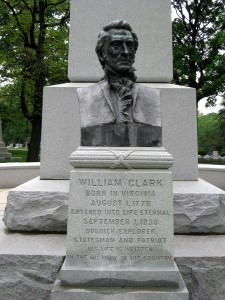
While my daughters and I walked about Clark’s grave site, I commented that it’s sometimes necessary to see their graves to remind yourself that the famous people in American history once really lived and walked about. They weren’t simply stories or legends.
Clark’s large monument contains several brief descriptions of his accomplishments. Even these few dozens of words are far more information than most of the dead get. As a general rule, almost nothing is written about most people at the cemetery. Even a six-word biography would be extravagant for most of the dead. This is a shame given that so many people accomplish so very much during their lives. Most people’s monuments will only bear their names and a couple of dates. It is ironic that Wikipedia entries, blog posts and other works written on paper or in cyberspace do far more than massive gravestones to tell others who we are. On the other hand, there is a relative permanence to a gravestone. It can’t be accidentally erased like a hard drive, even though a few hundred years of weather will melt even the most clearly carved letters into indecipherability.
Some families buy elaborate family plots, each individual member of the family eventually “earning” his or her own modest stone by his or her final passage. That is the case with the Augustine family, who purchased their large family plot many decades ago. The Augustines happen to be in my wife’s extended family. In fact, my wife and I have been told that we have the option to be buried in the spot pictured above. It’s a strange feeling, indeed, stepping on grass at the exact place where your remains might really end up (actually, each of us ends up in many places–the dead cells we constantly slough off–as well as the drops of moisture in our exhalings, as well as our urine, and our other waste products–are distributed so widely that, thanks to entropy, molecules of each of us end up almost everywhere on the planet).
While stopping by the office of Bellefontaine to get a map of the cemetery, I chatted with two Bellefontaine employees. I couldn’t help but notice the jargon they used when talking about the cemetery. They don’t talk about “graves” or “caskets” or “burials.” I assume that straight-forward terms like these are just too stark, the meaning too clear. Instead of talking about death and burials, the Bellefontaine workers exclaimed that the Augustine family had purchased an exquisite location on the grounds, right across the cemetery lane from some rather prestigious folks, including aviation pioneer James S. McDonnell, Jr.
They spoke of the cemetery almost as though it were a neighborhood for living people. Did someone say “neighborhood?” In several of portions of the cemetery, it looked like a neighborhood.
These mausoleums were big enough to house entire families. Presumably the neighborhood is quiet, even after sundown.
I must admit that there is quite a bit of “keep up with the Jones” action going on at this cemetery. All of this is in keeping with the predictions of Darwin. Whether it’s killer high heels or monuments in a cemetery, whether it’s during or after one’s lifetime, we strive to display our possession of material resources so as not be embarrassed or ostracized. Come to think of it, who knows whether or not the spirits of dead people get snooty after dark?
What can lots of money buy in a monument? One way to spend money is to hire some nymph-like females to tend to the dead.
 And notice the nose of the angel, below. It appears that visitors have been rubbing her nose over the years, keeping it from attaining a greenish glow. I’d personally have no problem with nymphs hovering about my grave, as long as they were pleasant and quiet.
And notice the nose of the angel, below. It appears that visitors have been rubbing her nose over the years, keeping it from attaining a greenish glow. I’d personally have no problem with nymphs hovering about my grave, as long as they were pleasant and quiet.
After all, cemeteries should be places where we can sleep. Ah, yes, sleep . . . I’ve been cranking much too hard at too many things for the past two years. Too much work and not enough sleep. So much so that I have this strange recurring thought when I drive by cemeteries. I think “You lucky bastards.” After all, they (presumably) get to sleep in. Please don’t get concerned with my recurring thought. I’m in no hurry to die (this sentence sounds so utterly ridiculous). You’d have to admit, though, that it would be refreshing to have no alarm clocks and no trash to take out. There’s no one to remind the dead of their failings. No taxes, just continued death. And, hopefully, lots and lots of sleep. Actually, I assume that it’s going to quite different than sleep.
Almost all of the dead have been dressed up with these massive and beautiful stones, under these majestic trees. It’s surprisingly easy to forget that you are walking on top of the remains of thousands of dead people. It’s too easy to forget how much many of those people are terribly missed by those still living.
Somehow, as my young daughters and I walked through the cemetery we started to feel “at home,” completely comfortable with our surroundings. There is a lot of human emotion that could be experienced in Bellefontaine, but most of that emotion is buried along with those bodies, or it is alive only in the minds of the surviving family members.
Yesterday, we snapped out of our art museum mood when we came upon a new grave, a burial site that didn’t yet have any fancy tomb or reassuring words. It didn’t even have a name. This burial site might be that of an old man, or a famous woman who started a big charity. Or it might have been a tiny child. We couldn’t tell, but the wilting flowers and the fresh mud reminded us that cemeteries are not just about expensive granite sculptures. They are mostly about human animals who no longer breathe and whose hearts no longer beat.
The elaborate monuments in Bellefontaine suggested to me, contrary to the maxim, that death is not actually the great leveler. In death, as in life, some are wealthier than others.
This simple new grave pictured above reminded me, however, that cemeteries are always about death, such that death really is the great leveler after all. And no amount of money, no business connections and no family loyalty can ever buy off the Grim Reaper.

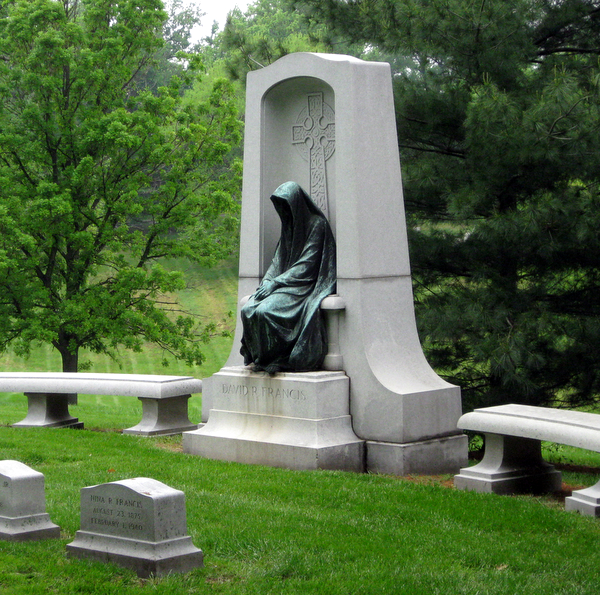


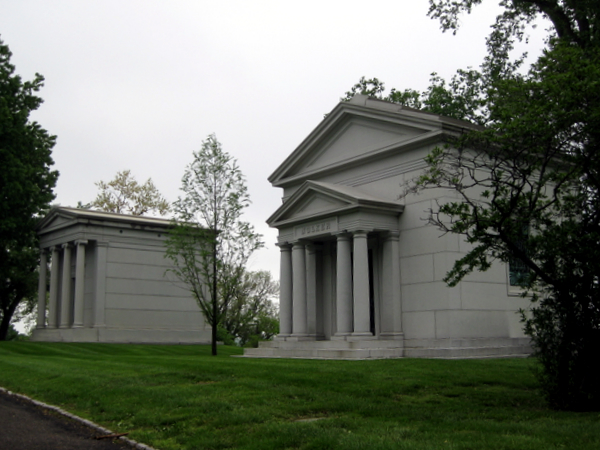
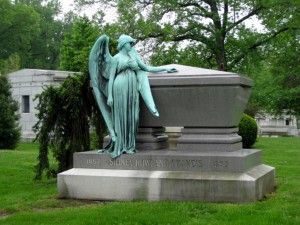
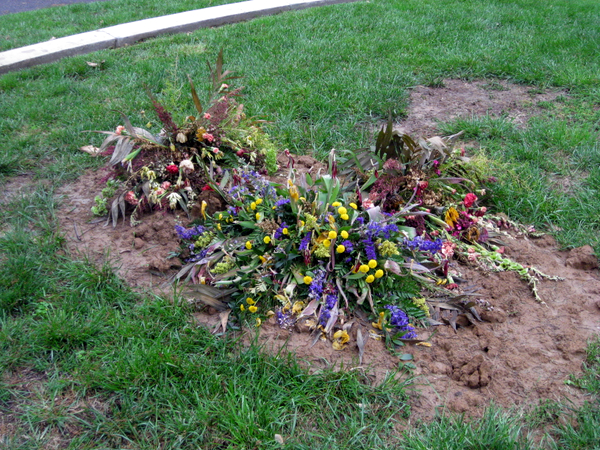

Ozymandias
I met a traveller from an antique land,
Who said: Two vast and trunkless legs of stone
Stand in the desert.
Near them, on the sand,
Half sunk, a shattered visage lies, whose frown
And wrinkled lip and sneer of cold command,
Tell that its sculptor well those passions read,
Which yet survive stamped on these lifeless things,
The hand that mocked them, and the heart that fed;
And on the pedestal these words appear:
'My name is Ozymandias, King of Kings;
Look on my works. Ye Mighty, and despair!'
Nothing beside remains. Round the decay
Of that colossal wreck, boundless and bare
The lone and level sands stretch far away.
This post reminded me of this Jewish cemetery that I visited with my class in Worms (I'm like 99% sure that it was in Worms and given that this is Europe's oldest preserved Jewish cemetery it makes sense. I would have to look at my pictures which I unfortunately do not have here, but the pictures here http://flickr.com/photos/johannjm/sets/7215760321… or here http://www.flickr.com/photos/typeoff/sets/7215759… match the ones I have in my memory.). I usually don't find cemeteries to be very thrilling, but that one was different. It looked like a scene from a fairytale, very peaceful and well, romantic. The tombstones were not ordered into rows, but distributed randomly (to my eyes at least, maybe there was some system that I hadn't been aware of) and with all the moss covering and giving them a weathered and ancient look they were forming natural embellishing parts of the landscape.